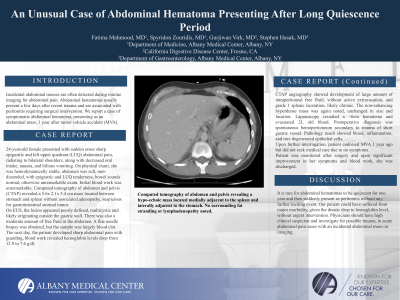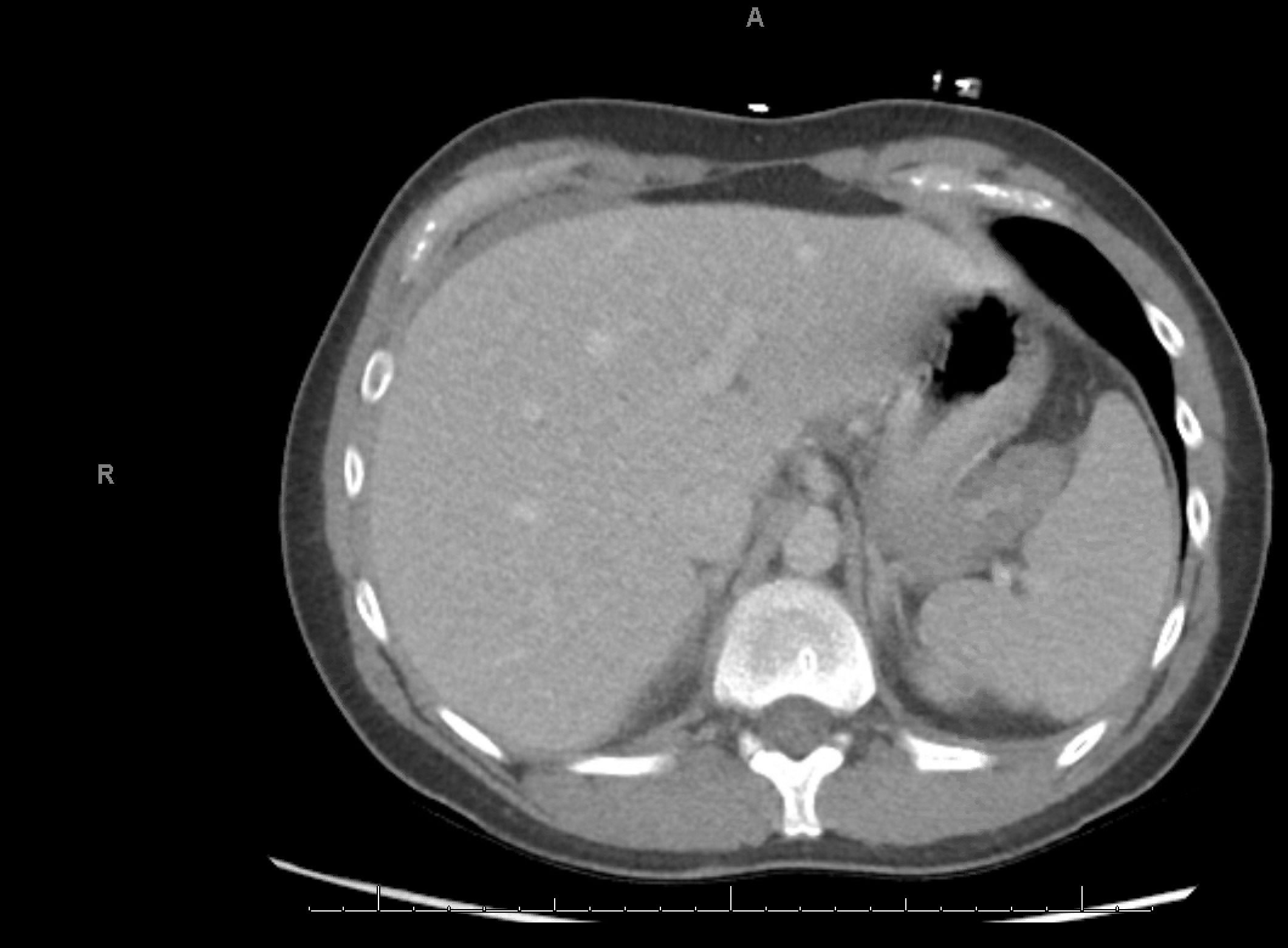Back


Poster Session A - Sunday Afternoon
Category: General Endoscopy
A0279 - An Unusual Case of Abdominal Hematoma Presenting After Long Quiescence Period
Sunday, October 23, 2022
5:00 PM – 7:00 PM ET
Location: Crown Ballroom

Has Audio

Spyridon Zouridis, MD
Albany Medical Center
Albany, NY
Presenting Author(s)
Fatima Mahmood, MBBS, Spyridon Zouridis, MD, Gurjiwan Virk, MD, Stephen Hasak, MD, MPH
Albany Medical Center, Albany, NY
Introduction: Incidental abdominal masses are often detected during routine imaging for abdominal pain. Abdominal hematomas usually present a few days after recent trauma and are associated with peritonitis requiring surgical intervention. We report a case of symptomatic abdominal hematoma, presenting as an abdominal mass, 1 year after motor vehicle accident (MVA).
Case Description/Methods: 24-year-old female presented with sudden onset sharp epigastric and left upper quadrant (LUQ) abdominal pain, radiating to bilateral shoulders, along with decreased oral intake, nausea, and bilious vomiting. On physical exam, she was hemodynamically stable, abdomen was soft, non-distended, with epigastric and LUQ tenderness, bowel sounds normal, otherwise unremarkable exam. Initial blood work was unremarkable. Computed tomography of abdomen and pelvis (CTAP) revealed a 5.6x 2.1x 5.4 cm mass located between stomach and spleen without associated adenopathy, suspicious for gastrointestinal stromal tumor.
On EUS, the lesion appeared poorly defined, multicystic and likely originating outside the gastric wall. There was also a moderate amount of free fluid in the abdomen. A fine needle biopsy was obtained, but the sample was largely blood clot.
The next day, the patient developed sharp abdominal pain with guarding, blood work revealed hemoglobin levels drop from 12.9 to 7.6 g/dl. CTAP angiography showed development of large amount of intraperitoneal free fluid, without active extravasation, and grade 1 splenic laceration, likely chronic. The non-enhancing hyperdense mass was again noted, unchanged in size and location.
Laparoscopy revealed a ~6cm hematoma and evacuated 2L old blood. Postoperative diagnosis was spontaneous hemoperitoneum secondary to trauma of short gastric vessel. Pathology result showed blood, inflammation, and rare degenerated epithelial cells.
Upon further interrogation, patient endorsed MVA 1 year ago but did not seek medical care due to no symptoms.
Patient was monitored after surgery and upon significant improvement in her symptoms and blood work, she was discharged.
Discussion: It is rare for abdominal hematomas to be quiescent for one year and then suddenly present as peritonitis without any further inciting event. Our patient could have suffered from major morbidity, given the drastic drop in hemoglobin level, without urgent intervention. Physicians should have high clinical suspicion and investigate for possible trauma, in acute abdominal pain cases with an incidental abdominal mass on imaging.

Disclosures:
Fatima Mahmood, MBBS, Spyridon Zouridis, MD, Gurjiwan Virk, MD, Stephen Hasak, MD, MPH. A0279 - An Unusual Case of Abdominal Hematoma Presenting After Long Quiescence Period, ACG 2022 Annual Scientific Meeting Abstracts. Charlotte, NC: American College of Gastroenterology.
Albany Medical Center, Albany, NY
Introduction: Incidental abdominal masses are often detected during routine imaging for abdominal pain. Abdominal hematomas usually present a few days after recent trauma and are associated with peritonitis requiring surgical intervention. We report a case of symptomatic abdominal hematoma, presenting as an abdominal mass, 1 year after motor vehicle accident (MVA).
Case Description/Methods: 24-year-old female presented with sudden onset sharp epigastric and left upper quadrant (LUQ) abdominal pain, radiating to bilateral shoulders, along with decreased oral intake, nausea, and bilious vomiting. On physical exam, she was hemodynamically stable, abdomen was soft, non-distended, with epigastric and LUQ tenderness, bowel sounds normal, otherwise unremarkable exam. Initial blood work was unremarkable. Computed tomography of abdomen and pelvis (CTAP) revealed a 5.6x 2.1x 5.4 cm mass located between stomach and spleen without associated adenopathy, suspicious for gastrointestinal stromal tumor.
On EUS, the lesion appeared poorly defined, multicystic and likely originating outside the gastric wall. There was also a moderate amount of free fluid in the abdomen. A fine needle biopsy was obtained, but the sample was largely blood clot.
The next day, the patient developed sharp abdominal pain with guarding, blood work revealed hemoglobin levels drop from 12.9 to 7.6 g/dl. CTAP angiography showed development of large amount of intraperitoneal free fluid, without active extravasation, and grade 1 splenic laceration, likely chronic. The non-enhancing hyperdense mass was again noted, unchanged in size and location.
Laparoscopy revealed a ~6cm hematoma and evacuated 2L old blood. Postoperative diagnosis was spontaneous hemoperitoneum secondary to trauma of short gastric vessel. Pathology result showed blood, inflammation, and rare degenerated epithelial cells.
Upon further interrogation, patient endorsed MVA 1 year ago but did not seek medical care due to no symptoms.
Patient was monitored after surgery and upon significant improvement in her symptoms and blood work, she was discharged.
Discussion: It is rare for abdominal hematomas to be quiescent for one year and then suddenly present as peritonitis without any further inciting event. Our patient could have suffered from major morbidity, given the drastic drop in hemoglobin level, without urgent intervention. Physicians should have high clinical suspicion and investigate for possible trauma, in acute abdominal pain cases with an incidental abdominal mass on imaging.

Figure: Computed tomography of abdomen and pelvis revealing a hypo-echoic mass located medially adjacent to the spleen and laterally adjacent to the stomach. No surrounding fat stranding or lymphadenopathy noted.
Disclosures:
Fatima Mahmood indicated no relevant financial relationships.
Spyridon Zouridis indicated no relevant financial relationships.
Gurjiwan Virk indicated no relevant financial relationships.
Stephen Hasak indicated no relevant financial relationships.
Fatima Mahmood, MBBS, Spyridon Zouridis, MD, Gurjiwan Virk, MD, Stephen Hasak, MD, MPH. A0279 - An Unusual Case of Abdominal Hematoma Presenting After Long Quiescence Period, ACG 2022 Annual Scientific Meeting Abstracts. Charlotte, NC: American College of Gastroenterology.
